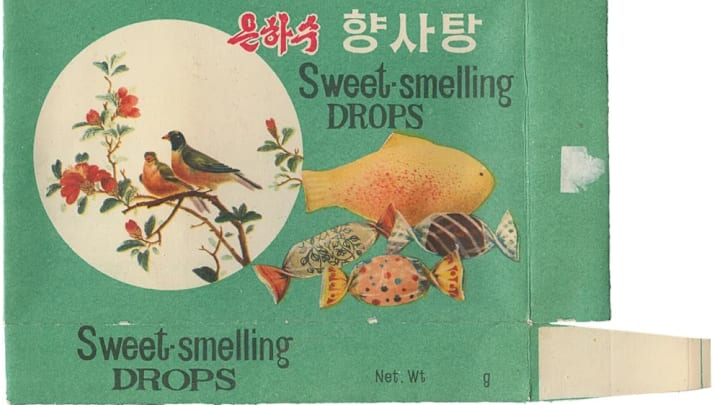Made in North Korea highlights everyday packaging and other designs from the isolated nation that Westerners rarely see.
For Westerners, life in North Korea remains shrouded in mystery. Despite the country’s growing tourism industry, it’s still very isolated—visitors are confined to strictly scheduled, guided tours, and it’s estimated that less than 20,000 of the country’s 25 million citizens are allowed to access the Internet (which is restricted to only a few dozen sites, anyway). Even once visitors make it into the Democratic People's Republic of Korea, they aren’t allowed to go just anywhere—foreigners couldn’t ride the entire Pyongyang subway system until 2016, for instance. Englishman Nicholas Bonner, who runs a Beijing-based tour company that specializes in visits to North Korea, has been traveling to the country regularly since 1993. Over the course of his visits, he’s managed to bring back a few souvenirs of life in the secretive nation. His new book, Made in North Korea: Graphics From Everyday Life in the DPRK (available from Phaidon), highlights sights that North Koreans see every day—graphic design on candy packaging, cans of food, cartons of cigarettes, postcards and more. The never-before-seen items are all from Bonner’s personal, eclectic collection of ephemera picked up on his decades of travel in North Korea.
1. A CANDY WRAPPER

“I was charmed and simply taken by the graphic design elements of the products there,” Bonner writes of his experiences in North Korea. “Many were not technically or legally ‘available’ to me, a foreigner. So I would buy Korean sweets and keep the wrappers."
2. LABEL OF A MEAT TIN

Over the course of his trips, Bonner writes, "the hoarding eventually became several large boxes stuffed with what others might, justifiably, call junk.”
3. A LENTICULAR POSTCARD

This 3D postcard highlights beauty products that contain ginseng, the root Bonner calls "the most quintessential of North Korean panaceas." Largely produced in the region of Kaesong, North Korea touts its ginseng as the best in the world. In 2010, the DPRK tried to pay off a debt to the Czech Republic with 22 tons of it. (The European country declined.)
4. A POSTCARD FEATURING MILITARY UNIFORMS

Bonner calls his collection "found objects," mostly collected along the tourist routes he travels and walking through Pyongyang. To curate a comprehensive collection of this sort would require more control over what he could buy, he implies, writing that foreigners aren’t allowed to enter most local shops. And so the items he includes in the book, he stresses, are purely a sampling of the most interesting designs he has been able to find, not a full survey of North Korea’s graphic design. This postcard is a New Year's greeting from 2004.
5. WRAPPING PAPER

This pink wrapping paper features some of Pyongyang's most famous architectural landmarks, with "Pyongyang, Korea" written in Korean, English, and Russian.
6. PACKAGING OF A CIGARETTE CARTON

Despite Kim Jong Il's proclamation that smokers are one of the "three great fools of the 21st century"—along with people who don't like music and those who don't understand computers—smoking remains popular among men in North Korea. (It is, however, taboo among women.) The country offers far more variety to choose from when it comes to cigarette brands than most other domestically produced goods. The competition for customers is fierce, and many companies produce gimmicky products to attract smokers. For instance, one of the cigarette types produced by the brand above, Pyongyang, features smiley faces on its filters.
7. A GUIDE TO "8 SCENIC WONDERS OF SONGUN"

This notebook listing scenic destinations associated with Songun, North Korea's "military first" policy, was given to Bonner and other business-class passengers on the state-owned airline Air Koryo. By 2014, when Korean-American journalist Suki Kim wrote her investigative book Without You, There is No Us about her time undercover as an English teacher in North Korea, the government had added four more "Wonders of Songun" for a total of 12. Most North Korean guides for tourists emphasize political propaganda over utilitarian travel tips.
8. AN ILLUSTRATION OF TWO DANCERS

The emblem of the Workers' Party, the DPRK's ruling party, appears as part of many everyday designs. This colorful sheet, which bears the emblem on the left-hand side, was an invite to a 1996 mass games event (a giant gymnastics and dance spectacular performed on national holidays) organized as part of the birthday celebrations for then-ruler Kim Jong Il.
9. A CARD

Since Bonner made his first trip to North Korea, the areas of the country where foreigners are allowed to travel have expanded widely. Though tourists in the early '90s could only access a few destinations outside Pyongyang, visitors now have a greater choice of hotels and destinations (though their itineraries must be strictly set and they are accompanied by two guides and a driver throughout their stay). Hotel welcome cards like the one above are provided to guests and bear sayings in English and Korean like "warm welcome" and "good night."

Made in North Korea: Graphics From Everyday Life in The DPRK is available on Amazon for around $32.
